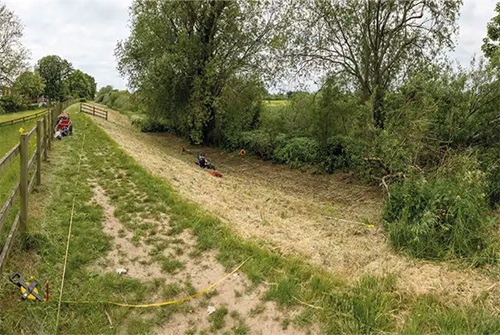
Badgers and other burrowing animals can weaken the structural integrity of flood defences. New devices being trialled by BGS use electrical resistivity to detect and map burrows in order to help find solutions.
The UK has over 7500km of embankments along its rivers and streams, protecting the communities and infrastructure behind them. But these vital flood defences can be weakened when burrowing animals like badgers, rabbits, and now beavers move in and weaken their structural integrity. When that happens, embankments are more likely to fail during a flood and leave the locations they protect vulnerable to flooding.
Until now, regulators and landowners have had no way to know where the badger burrows go underground or if the burrows have caused significant damage to the flood embankment.
Adrian White, a geophysicist from BGS, and his colleagues trialled a new technique on an embankment on the River Ouse, North Yorkshire, which protects Cawood, a village of 1500 people, from flooding.

"There have been several cases where badgers and other animals have caused embankments to fail, and it can happen very quickly if the burrows are in critical areas of the embankment," said White.
"Badgers are a protected species, so once they've been spotted at an embankment it can take months to deal with the problem. The burrows must be found, the badgers moved on, and then the site has to be repaired. And there's always the risk they could move 100 m down the road and find a new embankment to burrow into.
"The whole process takes months, is expensive and labour intensive, but we only find out if the burrows have damaged the embankment once the repair work starts."
Currently, ground penetrating radar (GPR) is used by scientists and consultants to map underground voids.
White continued: "We trialled electrical resistivity tomography (ERT) on the embankment. Similar to GPR, it's not invasive; we just insert electrodes into the ground that reach about 10 cm into the soil.
"ERT works by passing an electrical current between the electrodes inserted into the ground and measuring the voltage difference between other electrodes. It's a widely used technique and is already used to map subsurface geology and identify archaeological structures. The system allows the scientists to map the electrical resistance of the soil and, as the burrows are filled with air, which is very electrically resistive, they show up as resistive anomalies in ERT surveys.
"The ERT could detect badger burrows up to 1.5 m deep in the clay and map the structure of the badger sett, which had multiple entrances. It clearly outperformed the GPR, which doesn't work very well on clay-rich ground because the clay absorbs the radar waves.
"This is great news for the agencies and managers in charge of monitoring and repairing flood embankments: it can quickly assess stability, reduce repair costs and minimise the likelihood of unexpected failures during flood events.
"And, critically, it doesn't disturb the animals."
The UK has built flood embankments for hundreds of years, and they play a critical role in our flood defences in both rural and urban areas. In England and Wales, the Environment Agency maintains most, but landowners and farmers maintain some informal embankments.
"Burrowing by animals like badgers rapidly change how well an embankment can hold a flood back. One day, there can be nothing and the next, a whole load of tunnels. It's a huge challenge, and we must find better ways to mitigate the impact of our wildlife on what will be the last line of defence for some communities," commented White.
He added: "Recently, beavers have started to recolonise UK rivers, and it is hoped they will help reduce flooding. What is less well-known is that they are excellent burrowers. These burrows start below the water, so they may undermine flood defences without us knowing they are there. We'll need new techniques to find and map those, too."








